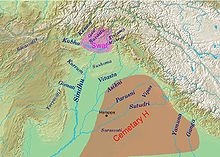Rigvedic rivers
The Rigveda refers to a number of rivers located in the northwestern Indian subcontinent, from Gandhara to Kurukshetra. They are located in present-day India, Afghanistan and Pakistan.

Rigvedic geography
The Rigveda mentions the sapta-sindhavaḥ (
“He has surveyed eight summits of the Earth, three shore or desert regions, seven rivers.” (aṣṭaú vy àkhyat kakúbhaḥ pr̥thivyā́s trī́ dhánva yójanā saptá síndhūn RV.I.35.8).[1]
Identification of Rigvedic hydronyms has engaged multiple historians; it is the single most important way of establishing the geography and chronology of the early
The same names were often imposed on different rivers as the Vedic culture migrated eastward from around Afghanistan (where they stayed for a considerable time) to the subcontinent via Punjab.[2]
List of rivers
Multiple hydronyms are located in the Rigvedic corpus; they are slotted according to rough geographical locations, following the scheme of Michael Witzel.[2] Alongside, opinions of scholars about modern correlates are provided:[4][5]
Indus:
Northwestern Rivers:
- Tr̥ṣṭā́mā – Blažek identifies with Gilgit.[4] Witzel notes it to be unidentified.[2]
- Susártu – Unidentified.
- Ánitabhā – Unidentified.
- Rasā́ – Described once to be on the upper Indus; at other times a mythical entity.[4]
- Mehatnū – A tributary of Gomatī́.[4] Unidentifiable.[2]
- Śvetyā́ – Unidentified.
- Kúbhā – Identified with Kabul river.
- Krúmu – Identified with Kurrum.
- Suvā́stu – Identified with Swat.
- Gomatī́ – Identified with Gomal.
- Saráyu / Harōiiu – Blažek identifies with Sarju.[4] Witzel identifies with Hari.[2]
- Kuṣávā – Probably Chitral river or Kunar.
- Yavyā́vatī – Noted to be a branch of Gomatī́. Witzel as well as Blažek identifies with Zhob River.[2][4] Dähnhardt comments it to be synonymous to Yamúnā or flowing very close to it[5] but Witzel had rejected a similar take by Talgeri.
Eastern tributaries:
- Suṣómā – Identified with Soan.
- Arjikiya – Blažek identifies with Haro.[4] Witzel speculates it to be Poonch or Tawi.[2]
- Rivers of Punjab:
Eastern Rivers:
- Áśmanvatī – Identified with Assan.
- Yamúnā – Identified with Yamuna.
- Aṃśumátī – Probably an epithet for Yamúnā.[4]
- Gáṅgā – Identified with Ganga.
See also
- Ap (water)
- Aryan migration
- Nadistuti sukta
- Old European hydronymy
- Out of India theory
- Rigvedic deities
- River goddess
- Samudra
- Zhetysu – 7 rivers of Central Asia
References
- ^ Wilson, H.H (27 August 2021). "Rig Veda 1.35.8 [English translation]". www.wisdomlib.org. Retrieved 22 May 2022.
- ^ a b c d e f g h Witzel, Michael (1998). "Aryan and non-Aryan Names in Vedic India: Data for the linguistic situation, c. 1900-500 B.C". In Bronkhorst, James; Deshpande, Madhav (eds.). Aryans and Non-Non-Aryans: Evidence, Interpretation and Ideology. Harvard Oriental Series. Cambridge. pp. 337–404.
{{cite book}}: CS1 maint: location missing publisher (link) - ^ "Sapta Sinhavas- The land of seven rivers" (PDF). M. Aslamkhan.
- ^ a b c d e f g h i j k l Blažek, Václav (2016). "Hydronymia R̥gvedica". Linguistica Brunensia. 64 (2). Masaryk University: 7–54.
- ^ ISBN 9788875432416.
- ISBN 0-415-10054-2
- JSTOR 635000.
Further reading
- General
- Blažek, Václav. "Hydronymia R̥gvedica". In: Linguistica Brunensia. 2016, vol. 64, iss. 2, pp. 7–54. ISSN 1803-7410.
- Gherardo Gnoli, De Zoroastre à Mani. Quatre leçons au Collège de France (Travaux de l’Institut d’Études Iraniennes de l’Université de la Sorbonne Nouvelle 11), Paris (1985)
